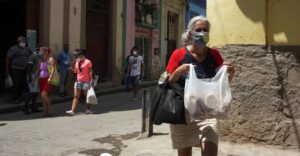Pope Benedict XVI will visit Cuba from March 26 to 28. He will celebrate two outdoor Masses, meet with Cuban President Raúl Castro, and visit with Cuban Catholic Church officials. This visit will draw the world’s attention to the economic and political changes underway; it will also raise important questions about the state of religious freedom in Cuba. In the context of the Pope’s Cuba visit, and with the hope of dispelling commonly held misconceptions about church-state relations in Cuba, WOLA has prepared a three-part series on the history and current state of religion in Cuba.
Conventional wisdom dictates that freedom of religion in Cuba is extremely limited; that churches are barely tolerated; that the relations between the Catholic Church and the Cuban Communist Party have improved little since the 1960s; that mutual hostility is the dominant motif in relations between churches and the state; that the Catholic Church in Cuba is eager to embrace the role that the Catholic Church played in Poland in the 1980s, serving as the spiritual voice for a nascent political opposition; and that the Catholic Church is not just the largest religious community in Cuba, but the only significant one. All of these assumptions are unfounded. This is the first installment in a three-part series, and it describes the faith communities that exist in Cuba today. The second installment details the ways that church-state relations have evolved since the Cuban Revolution, and the third shows how the Catholic Church and other faith groups are thriving and expanding their influence in Cuba, despite ongoing restrictions. This series has been prepared by WOLA’s Program Director Geoff Thale, who has studied religion in Cuba extensively.
Faith Communities in Cuba
The Catholic Church is the largest religious institution in Cuba today; Catholicism has historically been the dominant faith on the island. According to the Catholic Church’s records, 60 to 70 percent of Cuba’s population of more than 11 million people has been baptized in the Catholic Church. At the same time, baptized Catholics are not necessarily active churchgoers—the Church estimates that only 4 to 5 percent of Catholics regularly attend Mass. (This would make the population of regular churchgoing Catholics as low as 270,191 or as high as 394,029 assuming a population of 11,257,979 million, which is the World Bank’s 2010 estimate.)
Adding to this complexity is the reality that Afro-Cuban religious traditions remain strong on the island, even among Catholics. Africans were brought as slaves to Cuba as late as 1886, and there are at least three distinct Afro-Cuban religious traditions. The most well-known is Santeria, which combines religious traditions brought by enslaved Africans in the nineteenth century with elements of Catholicism. Santeria and other Afro-Cuban religious practices are not necessarily built around exclusive doctrinal beliefs, and many practitioners may also see themselves as Catholics or members of other religious traditions.
But Catholicism and Afro-Cuban traditions are not the only important religious expressions in Cuba. In addition to a significant Catholic population, Cuba has active Protestant churches, including a rapidly growing community of Protestant evangelicals. Many Protestant churches participate in the Cuban Council of Churches, including the Presbyterian, Episcopal, and Methodist churches and some Baptist conventions. (Many of these churches date back to when the United States intervened in Cuba in 1898. Following the U.S. intervention, Protestant missionaries from a wide variety of denominations arrived on the island and established scores of churches.) Currently, the membership of the diverse Protestant community numbers between 600,000 and 800,000, which includes both the faith traditions that belong to the Cuban Council of Churches and a growing number of evangelical and Pentecostal churches, including Assemblies of God and some Baptist groups.
Cuba is also home to a small but active Jewish community of about 1,500 active congregants, including Reform, Conservative, and Orthodox Jews. (In addition, there is a very small but long-standing Sephardic Jewish community). The Jewish community grew as significant numbers of eastern European refugees settled in Cuba in the early twentieth century. And it grew again as European Jewry fled Nazism in the 1940s; the community’s membership may have been as high as 15,000 in the 1950s. But the community’s numbers fell sharply in the 1960s when many Cuban Jews left the island as part of the anti-Castro exile community.
There are smaller communities of Muslims, Orthodox Christians, and others in Cuba. The number of religious practitioners in Cuba has been growing significantly since the early 1990s, when some legal barriers were removed and social stigmas reduced. Religious life in Cuba today is vibrant: the fact that Cuba’s religious community is so diverse and complex undercuts the notion that Cuba is an atheist country and raises questions about the extent to which the government actively represses religious practice.
________________________________________________________________________________
Geoff Thale is WOLA’s program director. Mr. Thale has followed issues of religious freedom in Cuba since the time of Pope John Paul II’s visit in 1998—conducting research, bringing Cuban religious leaders and scholars to the United States on a number of occasions, organizing public events on church-state relations in Cuba, and participating in a delegation of religious leaders to Cuba. More recently, Mr. Thale met with officials of the Catholic, Protestant, and Jewish communities in Cuba to discuss the Pope’s trip.


